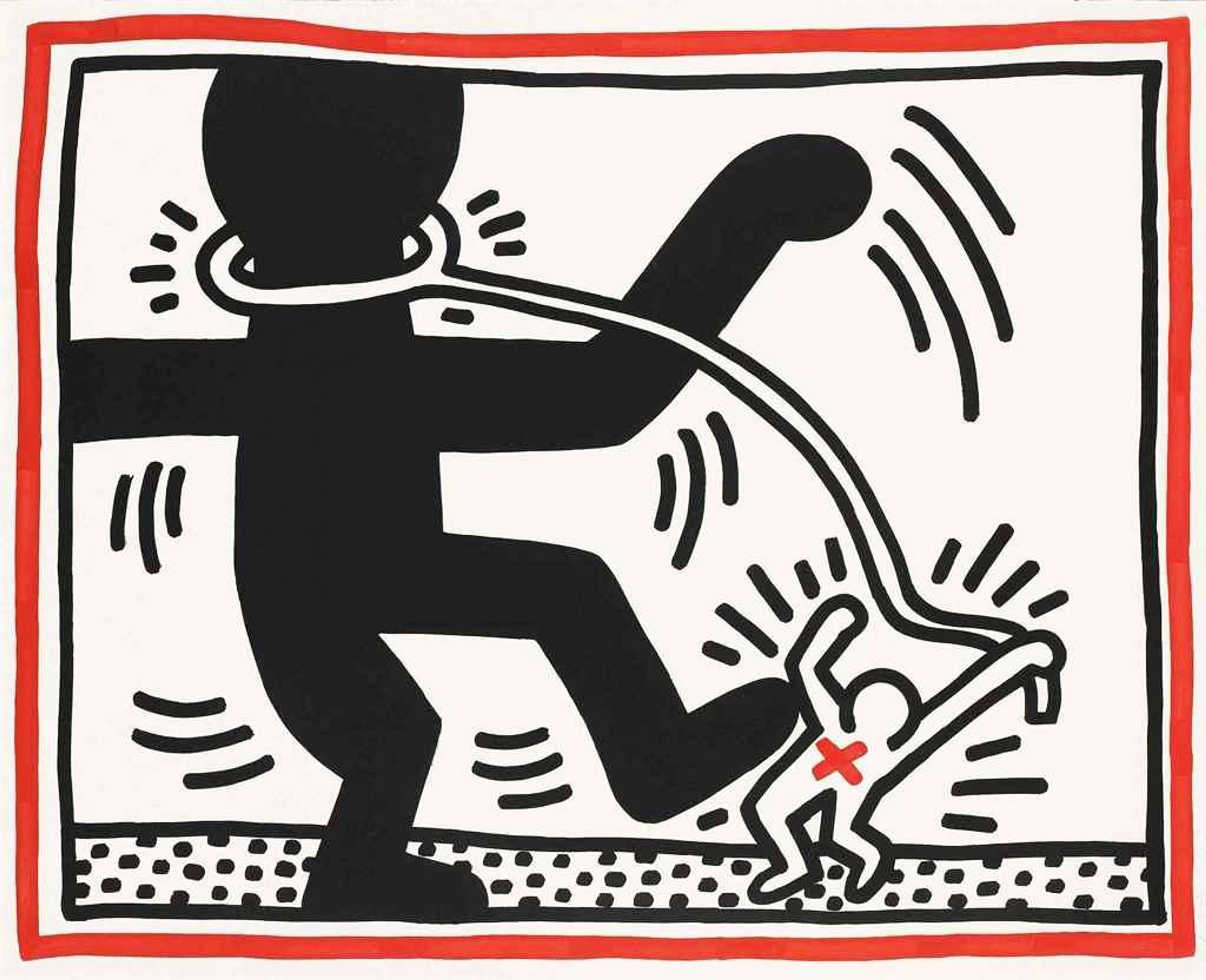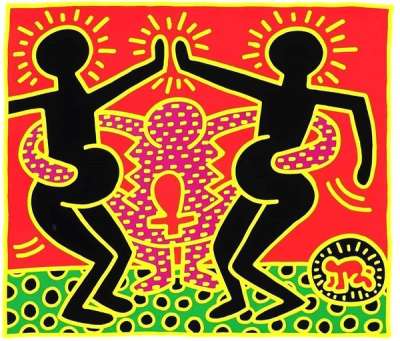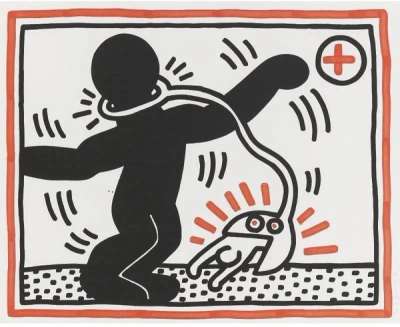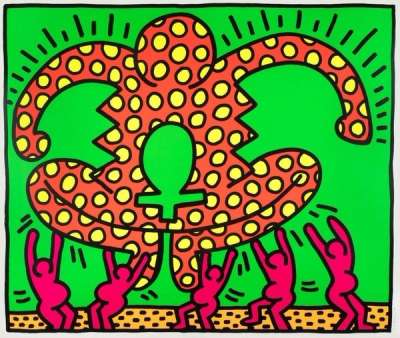Keith Haring's Impact on the Free South Africa Movement

 Free South Africa 2 © Keith Haring 1985
Free South Africa 2 © Keith Haring 1985
Keith Haring
250 works
In the midst of the politically charged atmosphere of the 1980s, Keith Haring distinguished himself as a pivotal figure in the intersection of art and social activism. His work, particularly the Free South Africa series, represents a critical engagement with the apartheid regime, utilising his unmistakable visual language to articulate a stance against systemic oppression. Haring’s Free South Africa prompts a deeper examination of the role of art in public life, raising the question: To what extent can an artist influence social and political change through their work?
Keith Haring’s Art of Activism
Haring emerged in the early 1980s as a groundbreaking artist, known for his energetic compositions that traversed the boundaries between the gallery and the urban landscape. His career was marked by a fervent commitment to social activism, using his art as a tool to address and spotlight critical social issues ranging from LGBTQ+ rights to racial inequality.
Haring's approach to art was inherently public and deeply infused with activism. He believed in the power of art to provoke discussion, challenge societal norms, and inspire change. This belief was manifested through his use of accessible imagery, public murals, and the integration of text to communicate directly with a broad audience. His art was not just seen; it was a call to action, a visual shout in the streets that demanded attention and contemplation.
Beyond his widely recognised street art and gallery exhibitions, Haring undertook projects that directly confronted global injustices and societal challenges. Notably, his Berlin Wall mural became an iconic symbol of freedom and resistance against oppression, capturing the world's attention and highlighting the artist's solidarity with movements for political change. Similarly, his Fertility Suite series exemplified Haring's concern with life, creation, and the human condition, offering a poignant commentary on the AIDS crisis and its impact on society. Through these and other works, Haring solidified his role as not just an artist, but as a proactive advocate for a more just and equitable world.
Keith Haring's Response to Apartheid
Apartheid, a system of institutionalised racial segregation and discrimination enforced by the government in South Africa from 1948 to 1994, subjected the non-White population to profound and pervasive injustices. Under apartheid, racial groups were separated, and the majority Black inhabitants were denied their basic human rights, leading to significant international outcry and a robust internal struggle for freedom and equality.
In response to the global call to dismantle apartheid, Haring created his Free South Africa series in the mid-1980s. This collection was Haring's artistic indictment of the apartheid regime, leveraging his signature visual language to critique the systemic oppression and racial discrimination prevalent in South Africa. Haring's series emerged as part of a larger thread of anti-apartheid activism that spanned various forms of cultural expression, including music, literature, and visual arts, as well as grassroots and international campaigns.
Through the Free South Africa series Haring contributed to this global chorus of dissent, translating the complex emotions and politics surrounding apartheid into compelling visual forms. His work, known for its impactful imagery and the strategic use of symbols, served not only as a political statement but also as a rallying cry for unity and action against the injustice of apartheid.
Haring's Artistic Evolution and Political Awakening
Haring's journey from a budding artist to a towering figure in the world of social activism art was marked by a distinctive evolution of style and substance. Initially influenced by the vibrant street culture of New York City, Haring's early work was characterised by simple, bold lines and vivid colours, drawing heavily on graffiti and street art's immediacy and accessibility. This period laid the foundation for what would become his iconic visual language, replete with symbols and characters that conveyed complex messages in an instantly recognisable style.
As Haring's career progressed, his work became increasingly infused with social and political commentary. The global political climate of the 1980s, marked by the Cold War tensions, the rise of the AIDS epidemic, and the ongoing struggle against apartheid in South Africa, deeply impacted Haring. His engagement with these issues reflected a significant shift in his thematic focus, as he began to leverage his art as a platform for advocacy and change.
Haring's political awakening was not just a personal transformation but also a reflection of the times. He saw the potential of art to transcend aesthetic appeal and become a tool for political expression and social change. This realisation was pivotal in shaping his later work, which tackled issues of racism, inequality, and injustice head-on. Through his art, Haring communicated a sense of urgency and a call to action, engaging with global political events in a way that was both profound and impactful. This evolution from an artist known for his playful, animated imagery to an activist artist committed to using his work to highlight and combat social injustices showcases Haring's remarkable journey and his enduring legacy as a voice for change.
A Closer Look at the Free South Africa Series
Haring's Free South Africa series utilises Haring's signature iconography to both critique the oppressive regime and express solidarity with the anti-apartheid movement. Each piece within the series is characterised by stark, impactful imagery and a deliberate use of symbols that convey a deep sense of injustice, resilience, and hope. Central to many of these works is the depiction of figures entangled in struggle—representing the conflict between the oppressed Black majority and the ruling White minority in South Africa. Haring employs contrasting colours and dynamic lines to dramatise this struggle, making the political personal and visually palpable.
One of the most recurring symbols in the series is the chain or rope, often shown binding or encircling figures. This motif powerfully symbolises the shackles of apartheid, suggesting both physical restraint and the broader systemic constraints imposed on Black South Africans. Yet, Haring's figures are not passive; they are depicted in motion, struggling against their bonds, embodying the spirit of resistance and the fight for freedom.
Another notable aspect of the series is Haring's use of space and composition to underscore the imbalance of power and the inherent injustice of apartheid. The oppressors are often depicted as smaller, overshadowed by the larger, more dominant representations of the oppressed, highlighting a moral and spiritual strength of those fighting against apartheid.
Methodology Behind the Message
Haring's approach to conveying political messages through art was multifaceted, employing a diverse range of mediums and visual strategies that extended his reach and amplified his impact. Haring understood the power of public art to communicate directly with a wide audience, and he strategically used public spaces and commercial products to advocate for social issues, including his stance against apartheid.
One of the methods Haring adopted is seen in his 1985 sculpture Untitled (Elephant). This piece represents both a continuity of Haring's signature style and a departure in terms of medium and scale. The sculpture, crafted from predominantly white paper mache and featuring distinct red tusks, stands out for its choice of materials and its significant size. Unlike Haring's more familiar works on canvas or public murals, this sculpture's three-dimensional form and tangible presence in space offered a new avenue for engaging viewers. The elephant, a powerful symbol often associated with memory, strength, and wisdom, can be viewed as a vessel for Haring's anti-apartheid message, with the red tusks possibly symbolising the violence and bloodshed of the regime. Although this work was intended as a new version of Warhol's original, its design bears a striking resemblance to Haring's Free South Africa series, both in style and timing. This similarity suggests that the sculpture could almost be viewed as a companion piece to Haring's suite, offering a parallel narrative or thematic extension to the series.
Haring's decision to create Untitled (Elephant) and other works across different mediums demonstrates his commitment to accessibility and his desire to use every possible channel to disseminate his messages. By placing his work in public spaces, Haring bypassed traditional art world gatekeepers, ensuring that his political commentary reached a broader audience. Similarly, his foray into commercial products allowed his anti-apartheid stance and other social messages to circulate in everyday contexts, further embedding his activism within the public consciousness.
Storytelling Through Iconic Figures
Within the series, Haring deviates from his typically vibrant and saturated colour palette to adopt a more restrained approach, employing primarily black and white with accents of red. This deliberate choice serves not only to highlight the starkness of apartheid's racial divisions but also to focus the viewer's attention on the power dynamics at play. Haring's compositions, marked by their simplicity and clarity, become a visual allegory for the struggle between the oppressed and their oppressors.
The figures within these works are intentionally sized to underscore the contrast between the majority and minority populations in apartheid South Africa. The black figures are depicted as significantly larger than their white counterparts, a choice that transcends mere physicality to suggest a deeper, latent strength and resilience within the oppressed community. This sizing is not just a commentary on the numerical majority of the black population but also a poignant statement on the inherent power and dignity that cannot be eclipsed by systemic oppression.
Haring's use of movement within these compositions shifts from his typical celebratory dance to a more profound depiction of liberation. The gestures and stances of the figures suggest a struggle for freedom, with the minimal yet bold use of red serving as a visual exclamation point that emphasises key elements of the narrative—be it the noose that symbolises control or the dashes that convey the vibrancy of the liberation movement.
Through this nuanced use of monochrome and composition, Haring communicates a potent message of resilience, resistance, and hope. His strategic choices in colour and sizing, coupled with the deliberate depiction of movement, not only enhance the visual impact of his work but also imbue it with a depth of meaning that speaks to the power of art as a tool for social commentary and change.
Haring's Legacy in Political Art and Activism
Haring's legacy in political art and activism resonates profoundly with subsequent generations of artists and activists, embodying a powerful testament to art's capacity to inspire change. Contemporary social movements continue to draw inspiration from Haring's practice, particularly his use of public spaces to democratise art and amplify messages of equality, justice, and human rights.
Street artists around the globe, from Banksy to STIK, echo Haring's approach, employing public walls as canvases to challenge oppression, catalyse community engagement, and foster solidarity among disparate groups. Haring's commitment to activism through art has inspired a new generation of activists to adopt creative strategies for protest, using art to visualise demands for change and capture the public's imagination. His legacy is a reminder of the enduring power of art to confront societal challenges, encouraging artists and activists alike to envision a more equitable world.






















